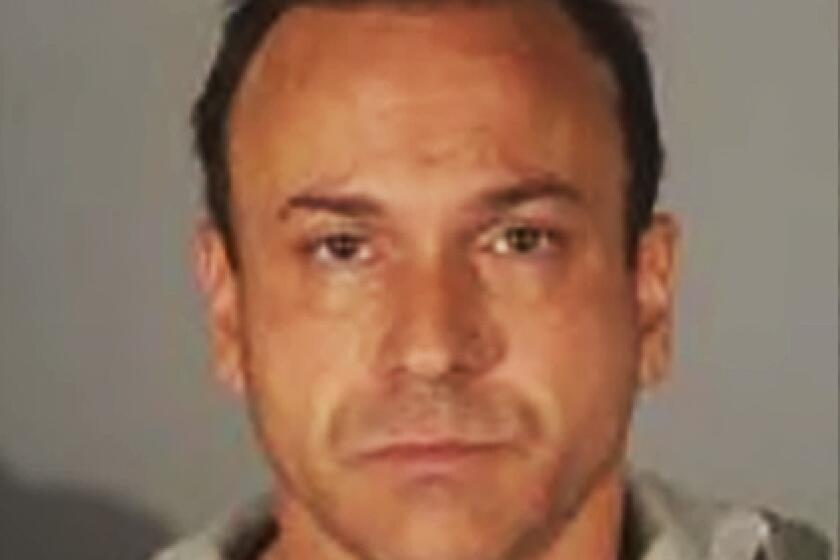Attorney general threatens to punish Stockton, San Bernardino and other ‘sanctuary cities’

Atty. Gen. Jeff Sessions moved Thursday to again punish so-called sanctuary cities, this time threatening to deny federal crime-fighting resources to four cities beset by violence if they don’t step up efforts to help detain and deport people living
In another move to pressure cities into cooperating with immigration enforcement, the U.S. Department of Justice threatened Thursday to withhold crime-fighting help from four cities — including two in California — if they refuse to help federal agents target jail inmates suspected of being in the country illegally.
But the decision to publicly question San Bernardino and Stockton as well as Baltimore and Albuquerque appeared poorly thought out. Perplexed officials in all four cities said they do not operate any jails. In two, officials said they have no sanctuary policies.
“The city of San Bernardino is not a sanctuary city,” Police Chief Jarrod Burguan said in an interview. Asked why he thought the city had been singled out by the Department of Justice, Burguan replied, “You would have to ask DOJ.”
In a publicly released letter to U.S. Atty. Gen. Jeff Sessions, Albuquerque Mayor Richard J. Berry pushed back, highlighting the agreement his police department has with immigration officials to screen people who are arrested.
A Justice spokesman did not reply to questions regarding why the cities were selected.
Each of the cities has been hit hard by surges in violent crime and expressed interest in joining a program that puts federal law enforcement manpower and resources in cities struggling with violent crime.
The letters are the latest threat by the Trump administration to crack down on so-called sanctuary cities — a label for cities that decline to assist immigration officers in various ways. Despite repeated threats, the federal government has not cut funding to any of the affected communities.
The letters asked each city about its “commitment to reducing violent crime stemming from illegal immigration” and for proof that it helps immigration officers take custody of people who are being held in local jails and suspected of living in the country illegally. A Justice Department spokesman said the new questions are “considerations, not requirements.”
Even though Thursday’s threats do not extend to stripping cities of existing funds, the stakes are nonetheless high for cities struggling to find ways to lift themselves out of spiraling crime.
San Bernardino has long been among the most violent cities in California, and its problems with crime have been compounded by deep financial struggles. Just this year, the city emerged from nearly five years of bankruptcy during which its police department suffered significant cuts. Last year, the city recorded its highest homicide total in two decades.
By taking simple, common-sense considerations into account, we are encouraging every jurisdiction in this country to cooperate with federal law enforcement.
— U.S. Atty. Gen. Jeff Sessions
As the police department works to rebuild, it has sought help from the federal government to help offset its limited resources. Late last year, city officials excitedly touted a $2.8-million grant from the Department of Justice to help fund 11 new officers.
The new assistance program the city wants to join, the National Public Safety Partnership, would help the department learn how other communities around the nation have successfully dealt with high violent crime rates, Burguan said.
Though the city has made some progress on its own, “I’m certainly in no position that I want to turn it down,” Burguan said of the sought-after help.
Similarly, homicides in Baltimore climbed into the triple digits through the first four months of 2017, the city’s highest murder rate per capita in recorded history, according to city officials. Violent crime was up 23% as of May 1, compared with the same time frame last year, with homicides, shootings and robberies all increasing by double digits.
Last week, the Justice Department announced that cooperation with immigration enforcement — specifically, agreements to let agents into jails to pick up people suspected of being in the country illegally — would be a condition for local police departments to receive a host of law enforcement-related grants totaling about $380 million for next year.
Significantly, in the letters sent this week, the department for the first time is asking whether cities are willing to comply with detainer requests from U.S. Immigration and Customs Enforcement. The detainers ask police to hold people for up to 48 hours after they would otherwise be released from custody in order to give ICE agents time to take them into federal custody. Some appeals courts have held that such requests, without warrants, are illegal. In light of the legal rulings, none of the county sheriffs in California — many of whom support a hard-line stance on immigration — honor detainer requests.
As in other immigration initiatives, the Trump administration’s sanctuary city crackdown has been frustrated by federal courts. A judge in San Francisco blocked an executive order from Trump that would have denied all federal funding to municipalities that refuse to assist on immigration enforcement. That case is still ongoing, along with other challenges to the order.
There is no clear agreement on what constitutes a sanctuary city. That confusion, along with gaffes by the Justice and Homeland Security departments along the way, have hamstrung the campaign.
In April, Homeland Security officials publicly released an online database of immigrants in detention that was supposed to help the public search for potential criminals, only to discover that children as young as 3 and 4 were included. Department officials said a filter was not properly applied to the data made available on the website.
And several months ago, immigration officials began publishing error-plagued reports on jurisdictions they said were releasing immigrants from jail or after arrest despite detainer requests. In some cases, ICE mixed up names, such as confusing Franklin counties in Iowa, New York and Pennsylvania. In other cases, the detainees had already been picked up by ICE or had never been released.
But Sessions, a strong proponent of lower immigration rates, has continued to push the cause aggressively, highlighting cases in which people in the country illegally have committed violent crimes and condemning sanctuary cities as havens for these criminals.
“By taking simple, common-sense considerations into account, we are encouraging every jurisdiction in this country to cooperate with federal law enforcement,” Sessions said in a statement that accompanied the letters Thursday. “That will ultimately make all of us safer — especially law enforcement on our streets.”
The letters sent this week presented a litmus test to the four cities. The police chiefs were given until Aug. 18 to show they have policies in place that call for jailers to honor the detainer requests, grant immigration officers access to their jails and provide notice before releasing an inmate ICE agents have said they want to take into custody.
It’s unfortunate when things like this become politicized.
— Stockton Police Chief Eric Jones
Because they run no jails, officials in San Bernardino, Baltimore and Albuquerque presumably will be able to argue the policy questions are irrelevant to them. In at least some of the cities, people who are arrested can be briefly detained in holding cells — rarely long enough for immigration agents to issue a detainer request. Then the inmates are sent to county and state facilities.
Stockton Police Chief Eric Jones said he was disappointed by the Department of Justice’s decision to use the program for political leverage.
“For us, it’s all about reducing violent crime. That’s what the PSP is about. It’s unfortunate when things like this become politicized,” he said.
The chief added that he does not see a connection between illegal immigration and violent crime in Stockton. While the city struggles with gang violence, most of those factions are “generational gangs that do not come from outside the country,” he said.
Despite years of increasing violence, violent crime is down 2% in Stockton so far this year, Jones said.
Twelve cities are already enrolled in the Public Safety Partnership, which enlists federal agents, analysts and technology to help communities find solutions to crime. The group includes Houston, which is challenging a state law that would compel cities to turn over immigrants.
Sergio Luna, an organizer with Inland Congregations United for Change — a coalition of religious groups and others that has for years pushed San Bernardino to do more to address its violence problems — said that by tying funding for crime reduction to immigration efforts, the federal government does a disservice to a community in real need of help.
“It’s unfortunate that the administration is basically telling its own citizens, ‘We’ll deny you funding for something you’re obviously in desperate need of just to advance our own agenda of cracking down on immigrants,’ ” he said. “I think it’s a bad situation for the entire population of San Bernardino and completely unfair for the immigrant community that is not even the root cause of the urban gun violence that takes place.”
Times staff writers Cindy Carcamo and Joel Rubin contributed to this report.
Follow us on Twitter: @jtanfani, @palomaesquivel and @JamesQueallyLAT.
ALSO
Congress takes aim at the Clean Air Act, putting the limits of California’s power to the test
Trump’s Cabinet seeks spiritual guidance from minister with a dim view of female politicians
Justice Department calls for review of race-based college admissions, alarming civil rights groups
UPDATES:
4:25 p.m.: This article was updated with comments from the cities that were sent letters as well as background about rising crime in some of those jurisdictions.
10:15 a.m.: This article was updated with staff reporting and details about violent crime in the cities that received letters.
This article was originally published at 7:55 a.m.
More to Read
Sign up for Essential California
The most important California stories and recommendations in your inbox every morning.
You may occasionally receive promotional content from the Los Angeles Times.













